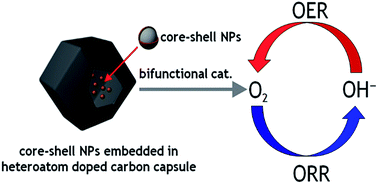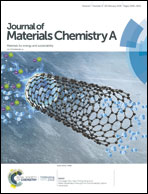Hollow capsules of doped carbon incorporating metal@metal sulfide and metal@metal oxide core–shell nanoparticles derived from metal–organic framework composites for efficient oxygen electrocatalysis†
Abstract
Durable and inexpensive catalysts for the reduction of molecular oxygen and evolution of oxygen from water are desirable for electrochemical applications. However, going beyond state-of-the-art catalysts that are based on expensive noble metals remains a major challenge. Recently, nanostructured composites of conductive carbons and earth-abundant metals or metal oxides have emerged as promising electrocatalysts. Herein, we report a versatile and inexpensive synthetic method for the production of metal@metal sulfide core–shell nanoparticles (metal = cobalt, nickel) embedded in the walls of sulfur- and/or nitrogen-doped hollow carbon capsules. Metal oxide nanoparticle shells were also generated as an alternative to the metal sulfide shells. The fabrication of these materials was achieved via the thermal decomposition of sacrificial metal–organic framework nanocrystals coated with a metal–tannic acid coordination polymer shell, which delivered zerovalent metal nanoparticles embedded in the walls of the nitrogen-doped hollow carbon capsules. Subsequent pyrolysis processing in the presence of thiourea produced the metal sulfide nanoparticle shell. Alternatively, an oxide shell was generated under oxidizing conditions. The supported metal@metal sulfide and metal@metal oxide core–shell nanoparticles proved to be excellent catalysts for the electrochemical reduction of oxygen and evolution of oxygen from water, and they were far superior to analogous zerovalent metal nanoparticles. The materials produced accordingly allow the elucidation of key structure–activity relationships, and these insights reveal promising next-generation catalysts for important electrochemical processes that are derived from earth-abundant components.



 Please wait while we load your content...
Please wait while we load your content...